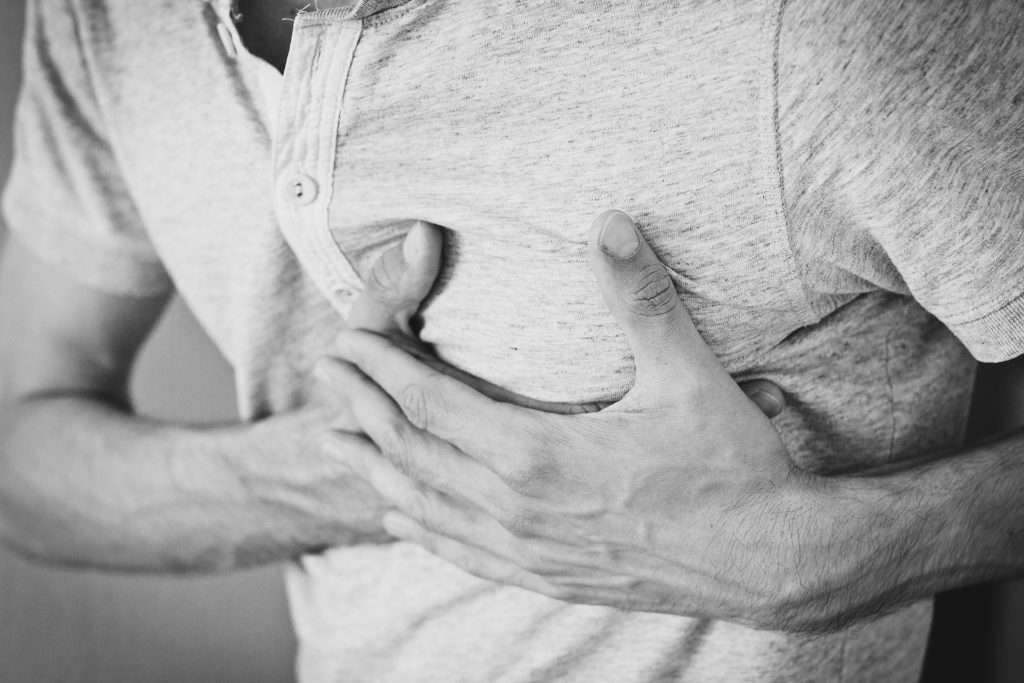The aim of this blog post is to provide you, our dear reader, some important facts and points about chest pain and thereby empower you to take the right decision when you or your loved one encounters it.
Chest pain is probably the most feared of all pains, mainly due to its association with heart problems. In fact, it is the second most common reason for presenting to the hospital emergency department across the globe (injury being the leading cause). Here are 5 common causes of chest pain and some tips to differentiate one from the other:
- Gastric acidity or heartburn
- Heart attack or angina
- Lung related causes
- Musculoskeletal problems
- Neurological pain
Gastric acidity or heartburn
Gastric acidity is also referred to as heartburn because it causes a burning sensation in the middle portion of the chest, typically behind the chest bone. The rising up of gastric juices from the stomach to the tube connecting the mouth and stomach (esophagus) and irritation of the inner lining of the tube is the cause for this burning sensation.
A few indicators of heartburn are:
- Timing of the pain – the pain might occur before a meal if you often have untimely meals or skip meals
- Association with food types – heavy meals or food with excessive oil and spice might trigger the discomfort
- Response to antacids – if the pain or burning sensation subsides with over-the-counter liquids or tablets for acidity, it is likely a heartburn
Heart attack or angina
Chest pain due to cardiac causes can be very severe and sinister. It is important to know that the following causes may lead to cardiac related chest pain:
- Sudden unbearable pain in the chest or upper part of the body due to a complete block of the blood vessel supplying the heart (myocardial infarction or heart attack)
- A gradually building up chest pain which worsens during exercise or emotional bursts and gets relieved with rest or relaxation is called angina and is due to poor blood supply to the heart
- A stabbing or piercing pain of the chest may be due to a tear of the major blood vessel leaving the heart or disease of the covering of the heart
Note: As heartburn and heart attack pain can mimic each other, it is best to see a doctor and get an electrocardiogram or ECG test at the earliest. Also, a healthy lifestyle which includes a balanced healthy diet in a timely manner, regular exercise and stress relieving techniques such as yoga, meditation and deep breathing, is extremely effective in keeping both heart related and gastric acidity related problems at bay.

Lung related causes
A few conditions like infection of the lungs, inflammation of the covering layer of the lungs, block in the artery supplying blood to the lungs and high blood pressure in the blood vessels carrying blood to the lungs can cause chest pain. The clues here are pain that worsens with deep breathing or coughing and at times associated with shortness of breath. As some of the causes are potentially lethal, it is imperative to consult a physician if the pain is severe or associated with difficulty breathing.
Musculoskeletal problems
Injuries to the muscles in the chest region or the ribs and the surrounding cartilages can cause chest pain. Pain on pressing a particular spot, also called tenderness, is an indicator of an underlying soft tissue or bony problem. The pain usually gets better with application of cold or hot fomentation or with anti-inflammatory drugs if it is soft tissue related.
Neurological pain
Any radiating pain in the neck, upper chest, upper back and arm can be due to nerve compression. The severity of pain may be more with upper body and arm movements and may be associated with other symptoms like tingling sensation, numbness etc.
Panic attack is another well-known cause of chest pain. You might not have any of the problems mentioned above but may experience a severe chest pain together with intense fear, rapid heartbeat, rapid breathing, profuse sweating, nausea and dizziness.
Shingles or herpes zoster infection of the chest region can cause a severe chest pain along with a band of blisters from the back to the front of the chest.
While chest pain may be due a variety of causes, cardiac and certain lung causes may be life threatening and should be addressed immediately without any time delay. So, here is the checklist for someone experiencing chest pain:
- Is this a new-onset pain?
- Is the pain severe or unbearable?
- Is the pain radiating (spreading from one point to other areas)?
- Is the pain associated with exercise or emotions?
- Is the pain associated with meals, cough, deep breathing etc?
- Is the pain getting better with over-the-counter drugs?
- Is the pain lasting for days to weeks?
- Is the pain getting better with local application of muscle relaxants or cold/hot fomentation?
While this post may come in handy when someone you know has chest pain, we strongly recommend consulting your physician to rule out serious medical conditions.